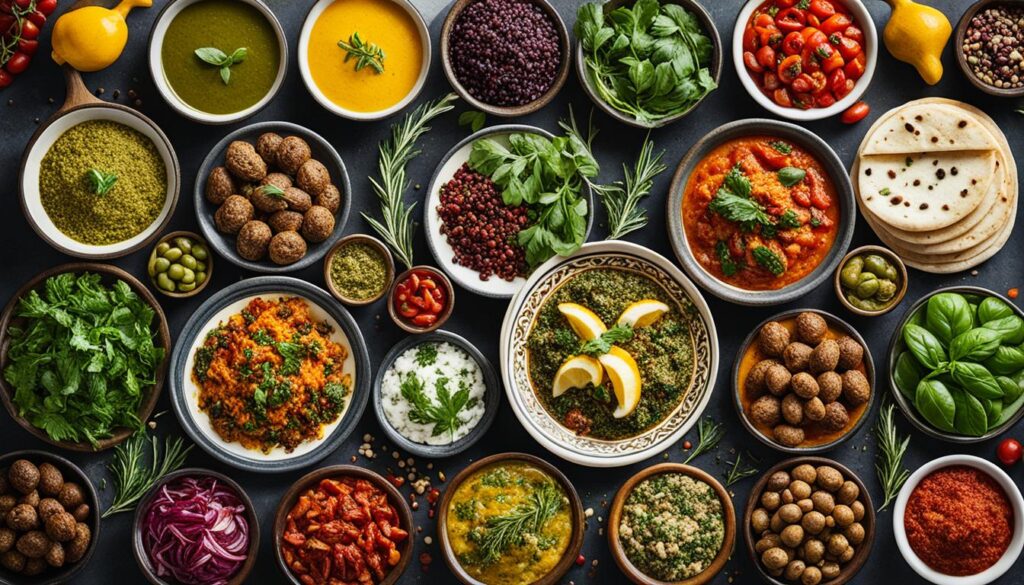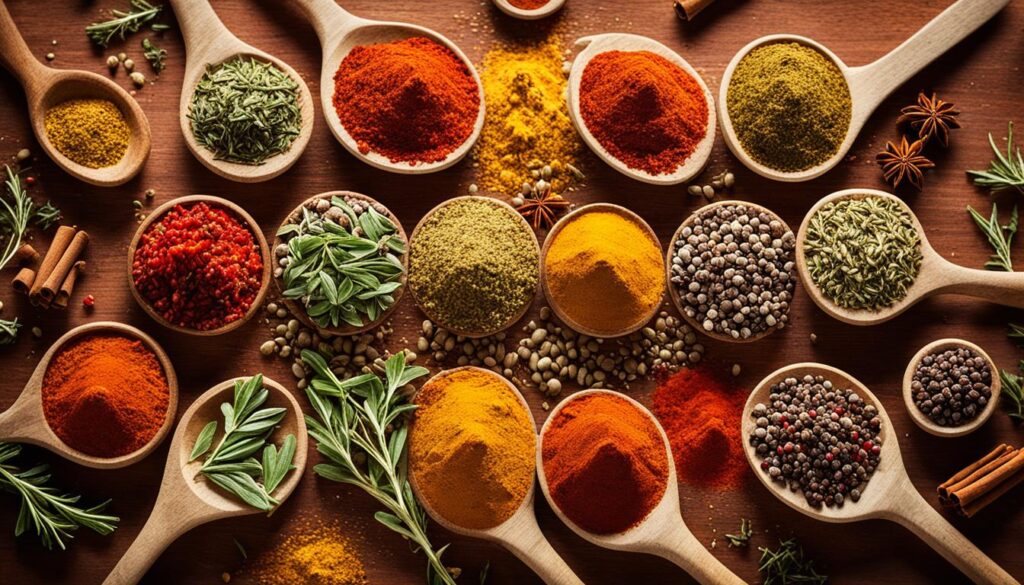Are you curious if Mediterranean food is from the Middle East? At first glance, these two food styles look similar. They both love using fruits, veggies, and healthy fats. They also use special spices. Yet, they each have their own unique flavors and traditions. Let’s explore to see what makes them different. We will look at where the food comes from, what they use, and their cultural influences.
The Geographic Scope of Mediterranean and Middle Eastern Cuisines
Mediterranean and Middle Eastern foods blend many tastes and traditions. While the Mediterranean area circles its sea, the Middle East includes lands further. These places have their unique food cultures, from Egypt to Iran.
Mediterranean Cuisine: Flavors from Around the Mediterranean Basin
In the Mediterranean, foods reflect its sunny lands. Greece and Italy to Spain and Morocco, the area is vast. They use fresh items like olive oil, veggies, and seafood. These dishes are often light and balance, showing off the region’s gifts.
Middle Eastern Cuisine: A Melting Pot of Culinary Traditions
The Middle East mixes many flavors from its varied lands. It cooks up dishes that use different spices and methods. From Iran’s rice to the Levant’s mezze, the foods are rich and diverse.
is mediterranean food middle eastern
While Mediterranean and Middle Eastern cuisines have some of the same ingredients and ways of cooking, they are different. The big difference is where the food comes from.
Mediterranean food is from places like Spain, Greece, and Italy, and the Ottoman Empire. On the other hand, Middle Eastern food comes from the Arabian Peninsula, Levant, and Iran among other places. This difference makes their dishes, tastes, and cooking methods unique.
Dishes like hummus, falafel, and kebabs are loved in both regions. But, they use different spices and flavors. For example, Middle Eastern cuisine likes to use spices like anise and sumac. In comparison, Mediterranean cooking leans towards sweet spices such as oregano.
In Mediterranean cooking, dishes with seafood are popular. This is because of the Mediterranean Sea’s nearness. Conversely, Middle Eastern dishes use more beans and legumes like fava beans.

The two food cultures both enjoy sharing food in small dishes, also known as meze. However, what’s found in these shared dishes can be different. For instance, Middle Eastern meze usually has tahini and kofta. In contrast, Mediterranean meze might have tzatziki and prosciutto.
Even though they’re different, Mediterranean and Middle Eastern traditions both love their own special foods. These are inspired by their unique histories and places. Both have brought delicious foods to the world.
Similarities and Differences in Ingredients and Dishes
Both the Mediterranean and Middle Eastern areas share tasty ingredients and dishes. They use a lot of fresh, flavorful foods. This includes yummy herbs, spices, and fresh fruits and veggies.
Shared Ingredients and Beloved Dishes
Important foods like chickpeas, eggplants, and tomatoes are found everywhere in these areas. Everyone loves dishes like hummus, falafel, tabbouleh, and baba ghanoush. You can also find delicious kebabs, grilled meats, and rice in both places. These items show their common food traditions.
Yet, the two regions also have their own unique foods. The Mediterranean area is famous for seafood and pasta. It has special dishes like paella. In contrast, the Middle East uses lots of legumes and grains. They enjoy dishes such as mujaddara and kibbeh.
This mix of shared and different foods makes each cuisine special. It lets people enjoy and learn about two amazing food cultures.
Spice Profiles: Warm and Earthy vs. Sweet and Aromatic
The taste of Middle Eastern and Mediterranean foods comes from their special spices. Middle Eastern food uses spices like harissa and saffron. These spices make the food warm and smell good.
On the other hand, Mediterranean cuisine prefers spices like oregano and rosemary. This makes their dishes taste sweet and smell nice. Both spice types are important for the unique tastes.
Choosing spices is about more than just liking certain flavors. It shows where the food comes from and its story. By learning about these spices, we understand the food better.

Food from these places is full of variety. You can taste the earthy spices in harissa or the sweet ones in oregano. It’s like a tasty trip through different kitchen adventures.
The Role of Seafood: A Coastal Influence
One big difference between Mediterranean cuisine and Middle Eastern cuisine is how much they use seafood. Nations around the Mediterranean Sea love their lamb. But they make more use of mediterranean seafood in their meals.
Think of dishes like paella, baked fish, niçoise salad, and shrimp soup. These foods show how the sea influences Mediterranean dishes. They’re full of flavor and show off the region’s love for mediterranean cuisine seafood.
On the contrary, middle eastern seafood isn’t as important in Middle Eastern meals. They focus more on foods like chickpeas, lentils, and lamb. So, seafood from the Middle East is not as rich in options.
The use of seafood really marks Mediterranean cooking. It gives dishes a taste of the sea. This makes Mediterranean meals stand out from Middle Eastern ones. It shows how the Mediterranean Sea shapes the food culture in the region.
Meze Culture: A Shared Tradition of Small Plates
In the Mediterranean and Middle East, people love meze. It means enjoying small shared dishes. Imagine chatting over coffee in Beirut. Or having dinner by the sea in Greece. You’ll experience the joy of sharing meze in both places.
Starting a meal with Middle Eastern meze is common. You’ll find hummus, baba ghanoush, and tabbouleh. These are served with warm pita and pickled veggies. It’s a tasty way to begin a meal.
Variations in Meze Presentations
Mediterranean meze and Middle Eastern meze have some difference too. The Mediterranean style focuses on small plates for light meals or gatherings. It’s meant for sharing and enjoying with friends.
- In the Mediterranean, meze features cheeses, olives, and seafood bites.
- Meze in the Mediterranean starts meals in a relaxed, social way.
- You might find fried items like calamari and falafel that show the region’s coastal life.
What matters most in Mediterranean small plates and Middle Eastern small plates is celebrating food. It’s about enjoying the tastes and talking with friends. Meze brings people closer and highlights the joy of their diverse foods.
Culinary Influences and Cultural Exchanges
Mediterranean and Middle Eastern kitchens have unique tastes. These come from long history and sharing of ideas. The Mediterranean is the meeting point of many lands. Its food mix comes from this rich exchange over time.
Middle Eastern food is a blend of many cultures too. Arabs, Persians, and others have added their mark. This mix shows in what they cook and how they cook it. They share a love for some spices and methods, showing years of learning from each other.
Olive oil is a great example of this sharing. It’s a must in Mediterranean meals. But, it’s now a favorite in Middle Eastern dishes too. The trading of olive oil connected these food traditions long ago.
Grilling meats is a big thing in both places. They use similar spices, making their foods taste alike. This shows how their food ways have mingled over the years.
Cultural influences mediterranean and middle east gave us hummus. It’s now loved in both places. This and many other dishes show how well their food styles have blended.
mediterranean cuisine cultural influences and middle eastern cuisine cultural influences have mixed deeply. This sharing has not just changed their food. It has also brought the world together through food.
Exploring the Flavors: Mediterranean and Middle Eastern Recipes
Exploring Mediterranean and Middle Eastern dishes helps us understand their unique flavors. From the fresh Greek farro salad to the spicy chicken tawook, each recipe is a journey through culture. By trying these recipes, I learn about the amazing tastes of these regions.
The Mediterranean diet is famous for its use of fresh, local foods. This leads to a healthy lifestyle. In the Middle East, spices like cumin and sumac make dishes amazing. Try foods like grilled kebabs, grilled octopus, or lamb stew for a flavor adventure.
Crave a fresh Mediterranean salad or the cozy Middle Eastern spices? There are so many dishes to try from these regions. Dive into their unique recipes. You’ll find amazing new favorite foods that will change how you see meals forever.
